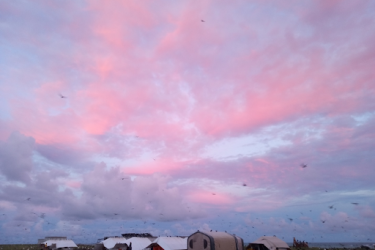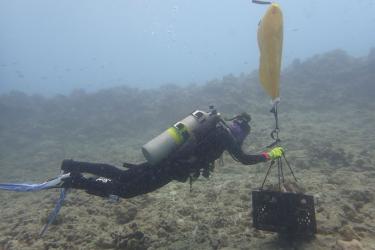After mass coral bleaching events across the Pacific Ocean, our scientists found major coral die-off in the Pacific Remote Islands in 2016 and 2017. Yesterday, NOAA Fisheries researchers aboard the NOAA Ship Hi‘ialakai set sail to assess the health of these coral reefs this year. On this 70-day mission to American Samoa and the Pacific Remote Islands, teams of scuba divers will conduct rapid ecological assessments of corals and reef fishes. They will study tiny inhabitants of corals such as small crabs, shrimp, and snails by installing and retrieving small collection devices called "autonomous reef monitoring structures." Additionally, researchers will measure physical and chemical characteristics of the coral reef environment such as water temperature, salinity, carbonate chemistry. The teams will also assess impacts of ocean acidification on coral reef growth and removal.

Baby octopus found on an autonomous reef monitoring structure in American Samoa. Photo: NOAA Fisheries/James Morioka.
The first leg of the expedition will cover the Pacific Remote Islands Marine National Monument's Howland and Baker Islands and American Samoa's Swains and Tutuila Islands. The Marine National Monument was created by Presidential proclamation in 2009 and expanded in 2014. January 2, 2025 the White House announced the renaming of the Pacific Remote Islands Marine National Monument to the Pacific Islands Heritage Marine National Monument. These monuments, located far from any major human populations, contain some of the most pristine coral reefs in the world, and offer unique opportunities to study how coral reef ecosystems function in the absence of direct human impacts.
The second and third legs of the expedition will take place across remaining areas of American Samoa, including Tutuila, Ofu and Olosega Islands, Taʻu Island, and Rose Atoll. Work by scientists aboard the Hiʻialakai compliments that of local management agencies, who use the ship to survey island areas that are otherwise hard to access.

Pink whipray (Himantura fai) on coral reefs at Swains Island in American Samoa. Photo: NOAA Fisheries/James Morioka.
On the Hiʻialakai's return voyage to Honolulu, during the fourth leg of the expedition, researchers will conduct surveys at three other islands in the Pacific Islands Heritage Marine National Monument: Jarvis Island, Palmyra Atoll, and Kingman Reef. The coral bleaching was especially severe at Jarvis Island, after a prolonged period of abnormally warm ocean temperatures in 2015–2016. These surveys will provide a critical opportunity to assess coral conditions and recovery at Jarvis Island, where our scientists observed 98% coral mortality last year.

Arc-eye hawkfish (Paracirrhites arcatus) in dead cauliflower coral (Pocillopora species) after coral bleaching at Jarvis Island in 2017. Photo: NOAA Fisheries/Brett Schumacher.
These studies will provide scientists and managers with valuable information about the ways coral reef ecosystems are impacted and (hopefully) recover from coral bleaching in remote locations. Studies in remote locations are especially useful because reefs in many of these locations are free from local stressors such as fishing and pollution.
The coral reef information from this expedition will add to a large set of ecological data that spans islands and archipelagos across the Pacific Ocean. With each expedition, the data set grows stronger and more valuable for evaluating changes to coral reefs over time and across regions. With data on the abundance and location of reef fishes and benthic organisms, and the oceanographic environment, scientists can monitor changes in the health and condition of coral reef ecosystems. This perspective enables federal and local resource managers to make informed decisions aimed at sustainable management of coral reefs throughout American Samoa and remote islands in the Pacific Ocean.




